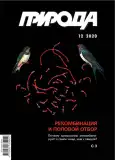«Oh, how many wonderful discoveries we have…» or the Role of Chance in Paleontology
- Authors: Komarov V.N1, Shpilevaya E.S1, Vaitieva Y.A1
-
Affiliations:
- Sergo Ordzhonikidze Russian State Geological Prospecting University
- Issue: No 12 (2020)
- Pages: 19-26
- Section: Articles
- URL: https://journals.eco-vector.com/0032-874X/article/view/627937
- DOI: https://doi.org/10.7868/S0032874X20120030
- ID: 627937
Cite item
Abstract
The article presents a description of a unique preserved belemnite residue — a fairly large fragment of a phragmocone preserved in the lateral section, partially destroyed in the front part, and a fragment of a rostrum. The phragmocone and the rock in its voids are partially pyritized. However pyritization process did not affect the undestroyed, not deformed part of the phragmocone, in which the chambers are filled with heterogeneous calcite. The fragments of the skeleton with the preserved primary carbonate composition alternate with completely pyritized fragments of the septa and the walls of the phragmocone. The complete absence of pyrite in the host rock and its presence inside the phragmocone indicates that its occurrence resulted from a biologically induced process. Most likely, it was formed in the sediments at the early stages of diagenetic redistribution of matter under reducing geochemical conditions below the sediment-surface water interface at the sites of organic matter decomposition in the phragmocone. The fossilization process, as well as the dimensions of the most important elements of the belemnite skeleton and the total length of its body, which was at least 110 cm, have been reconstructed.
Keywords
About the authors
V. N Komarov
Sergo Ordzhonikidze Russian State Geological Prospecting University
Email: komarovmgri@mail.ru
Moscow, Russia
E. S Shpilevaya
Sergo Ordzhonikidze Russian State Geological Prospecting University
Email: shpil-ka02@yandex.ru
Moscow, Russia
Yu. A Vaitieva
Sergo Ordzhonikidze Russian State Geological Prospecting University
Email: yulia.vaitieva@yandex.ru
Moscow, Russia
References
- Комаров В.Н. О неполноте геологической летописи. Статья 2. Об успехах в сокращении неполноты и не только. Известия вузов. Геология и разведка. 2010; 4: 3–9.
- Шпилевая Е.С., Вайтиева Ю.А., Комаров В.Н. Об уникальном образце (Mollusca, Cephalopoda) в учебной коллекции кафедры палеонтологии и региональной геологии МГРИ. Инновации. Наука. Образование. Электронное периодическое издание. 2020; 20: 728–742.
- Лукашенко С.В., Наянова Т.Ф., Комаров В.Н. Местонахождение ископаемых остатков зоны Virgatites virgatus в Нижних Мнёвниках (г. Москва) — уходящая натура. Известия вузов. Геология и разведка. 2009; 1: 3–7.
- Бондаренко О.Б., Михайлова И.А. Краткий определитель ископаемых беспозвоночных. М., 1984; 354.
- Dauphin Y., Williams C.T., Barskov I.S. Aragonitic rostra of the Turonian belemnitid Goniocamax: Arguments from diagenesis. Acta Palaeontol. Polon. 2007; 52(1): 85–97.
- Stevens K., Griesshaber E., Schmahl W. et al. Belemnite biomineralization, development, and geochemistry: The complex rostrum of Neohibolites minimus. Palaeogeogr. Palaeoclimatol. Palaeoecol. 2017; 468: 388–402.
- Ипполитов А.П., Барсков И.С., Косоруков В.Л., Десаи Бх. Микроструктурная и минералогическая архитектура ростров некоторых батских мегатеутидид (Belemnitida). Современные проблемы изучения головоногих моллюсков. Морфология, систематика, эволюция, экология и биостратиграфия. Материалы совещания. ПИН РАН. 2018; 5: 94–99.
Supplementary files











